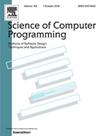用于自动驾驶汽车的量化神经网络的形式化规范和 SMT 验证
IF 1.4
4区 计算机科学
Q3 COMPUTER SCIENCE, SOFTWARE ENGINEERING
引用次数: 0
摘要
自动驾驶汽车的复杂性给其正式规范和验证带来了重大挑战,特别是在结合基于量化神经网络(qnn)的人工智能控制器时,它使用定点算法来适应嵌入式系统有限的计算能力。尽管qnn具有优势,但无论是使用整数还是位向量,这些网络的验证都被证明是pspace困难的。我们的方法侧重于详尽地验证表达为可满足模理论(SMT)证明目标的抽象场景。我们提出了一种QNN的形式化验证方法,该方法涉及分析具有摄动的网络的有理逼近,以确保摄动的有理神经网络的输出集包括QNN及其有理神经网络逼近的输出集。这些输出集之间的距离使用p-范数计算。为了评估我们的方法,我们使用了Highway-env自动驾驶汽车模拟器和z3 SMT求解器。本文章由计算机程序翻译,如有差异,请以英文原文为准。
Formal specification and SMT verification of quantized neural network for autonomous vehicles
The complexity of Autonomous Vehicles imposes significant challenges to their formal specification and verification, especially when incorporating AI controllers based on quantized neural networks (QNNs), which use fixed-point arithmetic to accommodate the limited computational capabilities of embedded systems. Despite the advantages of QNNs, verification of these networks, whether using integers or bit vectors, has proven to be PSPACE-hard.
Our approach focuses on exhaustively verifying abstract scenarios expressed as Satisfiability Modulo Theories (SMT) proof objectives. We propose a formal verification method for QNNs that involves analyzing a rational approximation of the network with perturbations to ensure that the output sets of the perturbed rational neural network include those of both the QNN and its rational neural network approximation.
The distance between these output sets is computed using the p-norm. To evaluate our methodology, we used the Highway-env autonomous vehicle simulator and z3 SMT solver.
求助全文
通过发布文献求助,成功后即可免费获取论文全文。
去求助
来源期刊

Science of Computer Programming
工程技术-计算机:软件工程
CiteScore
3.80
自引率
0.00%
发文量
76
审稿时长
67 days
期刊介绍:
Science of Computer Programming is dedicated to the distribution of research results in the areas of software systems development, use and maintenance, including the software aspects of hardware design.
The journal has a wide scope ranging from the many facets of methodological foundations to the details of technical issues andthe aspects of industrial practice.
The subjects of interest to SCP cover the entire spectrum of methods for the entire life cycle of software systems, including
• Requirements, specification, design, validation, verification, coding, testing, maintenance, metrics and renovation of software;
• Design, implementation and evaluation of programming languages;
• Programming environments, development tools, visualisation and animation;
• Management of the development process;
• Human factors in software, software for social interaction, software for social computing;
• Cyber physical systems, and software for the interaction between the physical and the machine;
• Software aspects of infrastructure services, system administration, and network management.
 求助内容:
求助内容: 应助结果提醒方式:
应助结果提醒方式:


